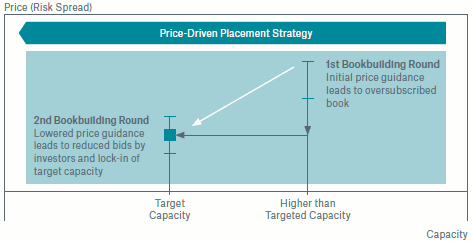The world’s largest reinsurer Munich Re recently published its latest quarterly ILS market update report which looks at the state of the catastrophe bond and ILS market at the end of Q3. The report contains some interesting insight from Munich Re’s Risk Trading team which looks at how the cost of issuing a 144A security can deter smaller insurers from issuing cat bonds and suggests one way to help make issuing a smaller cat bond transaction more cost-effective.
Because cat bonds are securities issued under Rule 144A, meaning they are only for sale to qualified institutional buyers (QIBs), the offering of insurance-linked securities comes with a number of fixed transaction costs attached, according to Munich Re’s report. Legal input from a deal counsel and an initial purchasers counsel account for some of these costs, as does the need for an independent risk modelling agency to provide a view of a cat bond or ILS deals riskiness. These costs are above the premium, or risk spread, of the deal and as such do not depend on the size of the transaction which can make smaller transactions less cost-effective.
Munich Re provide a graph showing these fixed costs in relation to a cat bond or ILS transactions volume and it clearly shows how the smaller the cat bond transaction the less cost-effective it becomes. This has the effect of making the cat bond market difficult for smaller insurers to access as they may not be able to issue a large enough transaction to keep the costs feasible to bear. Munich Re see the lower limit as being around $100m at least in comparison to the size of expenses incurred by placing the risk in the traditional reinsurance markets. However all is not lost, Munich Re says that it can be done and in fact their most recent transaction Queen Street VII Re Ltd. was only $75m in size. Munich Re says that it requires an “aggressive and efficient execution strategy” to issue a smaller cat bond and advises smaller insurers to operate a “price-driven placement strategy” if they choose to access the cat bond and ILS market.

Issuance volume vs fixed costs for a 3 year catastrophe bond - Source: Munich Re Q3 2012 ILS market report
Issuance activity so far in 2012 shows how insurers have been making the most of the abundant capital in the marketplace and strong investor appetite for ILS and cat bonds as an asset class. This has enabled sponsors to upsize transactions, on average, by around 42% from the initially planned volumes. This shows a “capacity-driven placement rationale”, according to Munich Re, meaning that the deal is marketed with a price range and then once oversubscribed the price is locked in to upsize by the level of oversubscription.
For smaller insurers Munich Re advises a different strategy, saying that the price-drive placement is a better option for them and can enable them to offset some of the fixed costs by achieving more attractive pricing. Once an offering is oversubscribed a second bookbuilding, round can happen with tighter guidance on pricing. This can result in lower bids from the investors in the bond which can allow the targeted capacity to be achieved at a reduced price or spread.
This could be beneficial for smaller insurers, enabling them to issue smaller cat bonds or ILS while offsetting some of those fixed costs. Munich Re says it could be particularly relevant for smaller insurers looking for risk transfer for single perils in a limited region. That could also be very attractive to sponsors looking for geographic diversification. Munich Re also notes that fixed costs can be further reduced by extending the typical cat bond length to four or more years.
Munich Re says that on recent transactions where they were sponsor the fixed costs come to roughly $1.5m. They offer an example, a $50m regionally limited cat bond where they estimate that the annual risk spread could be reduced by around 50 basis points (0.5%) if a price driven execution strategy is undertaken. Over a four-year deal that could equal a $1m saving over the term of the deal so offsetting as much as two-thirds of the fixed transaction costs. Suddenly that makes cat bonds at $50m or even less seem much more achievable.

How catastrophe bond spreads can be reduced through oversubscription - Source: Munich Re Q3 2012 ILS market report
This is fascinating insight from Munich Re which will surely be of great interest to smaller U.S. property and casualty insurers who may have been thinking about how to afford to issue a 144A catastrophe bond. The market would certainly welcome smaller, very peril and geography specific transactions as they would add an interesting element to portfolio diversification for investors. Other ways to reduce cat bond issuance costs do exist, such as privately executed transactions which can be much smaller as costs can be much lower or using a facility which offers or can help to facilitate cheaper cat bond issuance such as Shima Re, Kalista and Robus all offer.
You can download a copy of the Q3 2012 ILS market report from Munich Re via the Risk Trading section of their website. You can also read our earlier article covering the report: Cash flooded ILS funds drive ILS and cat bond market to record size
 View all of our Artemis Live video interviews and subscribe to our podcast.
View all of our Artemis Live video interviews and subscribe to our podcast.
All of our Artemis Live insurance-linked securities (ILS), catastrophe bonds and reinsurance video content and video interviews can be accessed online.
Our Artemis Live podcast can be subscribed to using the typical podcast services providers, including Apple, Google, Spotify and more.































